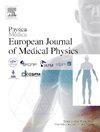LatticeOpt: An automatic tool for planning optimisation of spatially fractionated stereotactic body radiotherapy
IF 2.7
3区 医学
Q1 RADIOLOGY, NUCLEAR MEDICINE & MEDICAL IMAGING
Physica Medica-European Journal of Medical Physics
Pub Date : 2024-09-26
DOI:10.1016/j.ejmp.2024.104823
引用次数: 0
Abstract
Purpose
Lattice radiotherapy (LRT) is a three dimensional (3D) implementation of spatially fractionated radiation therapy, based on regular spatial distribution of high dose spheres (vertices) inside the target. Due to tumour shape heterogeneity, finding the best lattice arrangement is not trivial.
The aim of this study was to develop the LatticeOpt tool to generate the best lattice structures on clinical cases for treatment planning.
Methods
Developed in MATLAB, LatticeOpt finds the 3D-spatial configurations that maximize the number of vertices within the gross target volume (GTV). If organs at risk (OARs) are considered, it chooses the solution that minimizes the overlapping volume histograms (OVH). Otherwise, the lattice structure with the minimum Hausdorff distance between vertices and GTV boundary is chosen to avoid unpopulated regions.
Different lattice structures were created for 20 patients, with (OVHopt) and without (OVHunopt) OVH minimization. Imported into TPS (Eclipse, Varian), corresponding plans were generated and evaluated in terms of OAR mean and maximum doses, GTV vertex coverage and dose gradients, as well as pre-clinical plan dosimetry.
Results
Plans based on an optimized lattice structure (OVHopt, OVHunopt) had similar dose distributions in terms of vertex coverage and gradient index score. OAR sparing was observed in all patients, with a 4 % and 9 % difference for mean and max dose (both p-values <0.01), respectively. The best vertices dimensions and their relative distances were patient dependent.
Conclusions
LatticeOpt was able to reduce the time-consuming procedures of LRT, as well as to achieve standardized and reproducible results, useful for multicentre studies.
LatticeOpt:空间分割立体定向体放射治疗规划优化自动工具
目的 网格放射治疗(LRT)是一种三维(3D)空间分割放射治疗方法,基于靶体内高剂量球体(顶点)的规则空间分布。本研究的目的是开发 LatticeOpt 工具,以便在临床病例中生成最佳的格子结构,用于制定治疗计划。方法 LatticeOpt 是在 MATLAB 中开发的,它能找到使总靶体积(GTV)内顶点数量最大化的三维空间配置。如果考虑到危险器官(OAR),则选择重叠体积直方图(OVH)最小的解决方案。否则,将选择顶点与 GTV 边界之间 Hausdorff 距离最小的晶格结构,以避免出现未填充区域。我们为 20 名患者创建了不同的晶格结构,包括(OVHopt)和(OVHunopt)OVH 最小化。结果基于优化晶格结构(OVHopt、OVHunopt)的计划在顶点覆盖和梯度指数评分方面具有相似的剂量分布。所有患者都观察到了OAR疏散,平均剂量和最大剂量分别相差4%和9%(p值均为0.01)。结论LatticeOpt能够减少LRT的耗时过程,并获得标准化和可重复的结果,对多中心研究非常有用。
本文章由计算机程序翻译,如有差异,请以英文原文为准。
求助全文
约1分钟内获得全文
求助全文
来源期刊
CiteScore
6.80
自引率
14.70%
发文量
493
审稿时长
78 days
期刊介绍:
Physica Medica, European Journal of Medical Physics, publishing with Elsevier from 2007, provides an international forum for research and reviews on the following main topics:
Medical Imaging
Radiation Therapy
Radiation Protection
Measuring Systems and Signal Processing
Education and training in Medical Physics
Professional issues in Medical Physics.

 求助内容:
求助内容: 应助结果提醒方式:
应助结果提醒方式:


